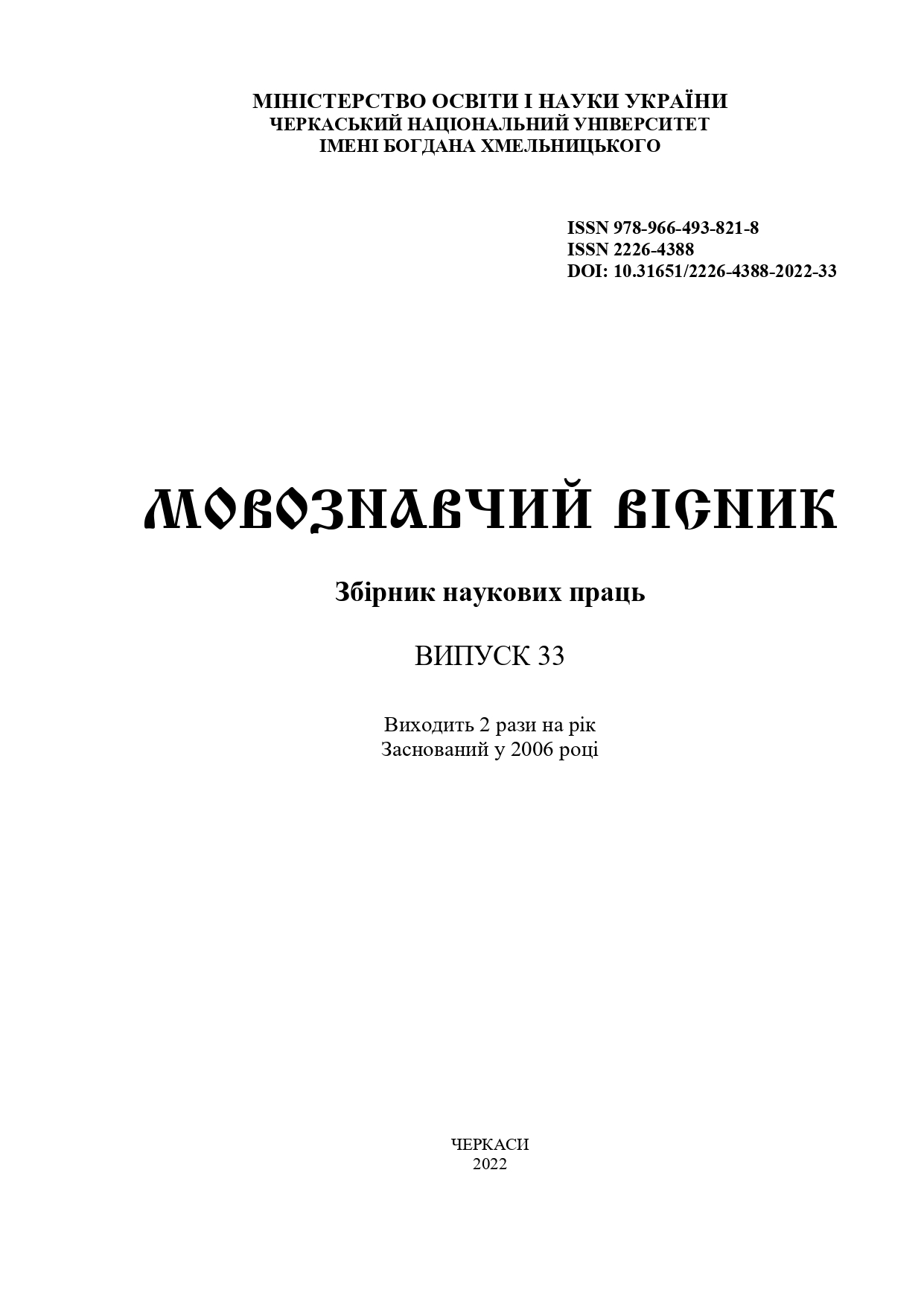EPISTOLARY DISCOURSE OF THE UKRAINIAN LANGUAGE OF THE SECOND HALF OF THE 17th CENTURY THROUGH THE PRISM OF PHRASEOLOGY
Main Article Content
Abstract
Introduction. Lazar Baranovych’s epistolary heritage in Ukrainian studies did not find proper elaboration, though, representing a fragment of the work of the Archbishop of Chernihiv, it was and still remains the source of the study of the linguistic situation in the second half of the 17th century.
Purpose. The purpose of the article is a semantic analysis of phraseological units recorded in the letters of Lazar Baranovych, in their vertical time projection.
Methods. In order to achieve the declared goal, the main contextual, comparative, descriptive methods, discourse analysis, partly methods of structural-grammatical modeling and comparative-historical.
Results. The analyzed letters testify that most of the recorded phraseological units have a negative connotation as a result, on the one hand, of mental critical attitude of Ukrainians to their actions, doings, character traits, on the other – the situation in Ukrainian society of the Ruins era, which significantly affected the church. Most recorded phraseological units are verb-preposition-noun or verb-noun constructions. Some of them are characterized by the presence of optional components, which can be adjectives, pronouns, verbs and which, while extending the set structure, specify semantics of the phraseological unit. Word order in phraseological units does not yet have a clear consolidation, which allows to distinguish the so-called inversion variants. Epistolary of Lazar Baranovych testifies to the formation of systemic relations in phraseological composition of the Ukrainian language of the second half of the 17th century. Borrowed or calqued phraseological units engage in synonymous and antonymic
relationships with each other or with Church Slavonic or Ukrainian, creating a linguistic competition between the Church’s written tradition and the element of life.
Originality. Lazar Baranovych’s epistolary became the object of phraseological research for the first time. The analyzed set expressions with corresponding lexical and grammatical transformations were inherited by the new Ukrainian language, which proves the continuity of the development not only of phrasicon, but of the Ukrainian language as a whole.
Conclusion. The main provisions concerning the study of the intersection of the traditional business style with the epistolary at the phraseological level will allow the correct interpretation of the language practice of Ukrainians in the 17th century taking into account interlingual communication. We see the research prospects in the analisis of phraseology of monuments of epistolary discourse, which will allow us to trace the features of individual phrase formation in the all-Ukrainian phraseological context.
Article Details
References
Denisyuk, V. V. (2018). Dinamicheskiye protsessy verbalizatsii prisyagi (na materiale
vostochnoslavyanskikh letopisey XVI–XVIII vv.) [Dynamic processes of oath verbalization (on the material of East
Slavic chronicles of the 16th – 18th centuries)]. In: Slavyanskiye yazyki: sistemno-opisatel’nyy i sotsiokul’turnyy
aspekty issledovaniya [Slavic languages: system-descriptive and socio-cultural aspects of the study]: sb. nauch. tr. /
Brest. gos. un-t im. A. S. Pushkina; redkol.: L. A. Goduyko [i dr.]; pod obshch. red. O. B. Perekhod. Brest: BrGU, 1,
–141 (in Russ.).
Denysiuk, V. V. (2022). Epistoliarii Lazaria Baranovycha yak dzherelo vyvchennia dynamiky
frazeolohichnoho skladu ukrainskoi movy druhoi polovyny XVII st. [Lazar Baranovych’s epistolary as a source for
studying the dynamics of the phraseological composition of the Ukrainian language of the second half of the 17th
century]. In: Visnyk Zhytomyrskoho derzhavnoho universytetu imeni Ivana Franka. Filolohichni nauky [Bulletin of
Zhytomyr Ivan Franko State University. Philological sciences]. 1 (96), 60–76 (in Ukr.).
Zhaivoronok, V. V. (2006). Znaky ukrainskoi etnokultury. Slovnyk-dovidnyk [Symbols of Ukrainian
ethnoculture. Dictionary-reference]. Kyiv : Dovira, 703 (in Ukr.).
Zoltan, A. (2006). Frazeologizm lomat’ golovu v sravnitel’nom aspekte (po povodu vykhoda novogo
izdaniya knigi «Russkaya frazeologiya. Istoriko-etimologicheskiy slovar’» pod red. V. M. Mokiyenko)
[Phraseologism ломать голову in a comparative aspect (on the issue of a new edition of the book «Russian
Phraseology. Historical and Etymological Dictionary» edited by V. M. Mokienko)]. In: Russkaya, ukrainskaya i
rusinskaya leksikologiya i leksikografiya [Russian, Ukrainian and Rusyn lexicology and lexicography]: sbornik
statey pamyati professora Ishtvana Udvari. – Orosz, ukrán és ruszin lexikológia és lexikográfia. Tanulmánykötet
Udvari István professzor emlékére. Nyíregyháza: Krúdy, 133–143 (in Russ.).
Lazarenko, O. M. (2000). Mova lystuvannia Lazaria Baranovycha iz kozatskymy hetmanamy [The
language of Lazar Baranovich’s correspondence with the Cossack hetmans]. In: Novi doslidzhennia kozatskoi doby v
Ukraini [New studies of the Cossack period in Ukraine]: zb. nauk. statei. Kyiv, 9, 177–181 (in Ukr.). 6. Mokiyenko, V. M. & Nikitina, T. G. (2008). Russkoye skvernosloviye. Kratkiy, no vyrazitel’nyy
slovar’ [Russian obscene language. A concise yet expressive dictionary]. Moskva: ZAO «OLMA Media Grupp»,
(in Russ.).
Stavytska, L. (2008). Ukrainska mova bez tabu: Slovnyk netsenzurnoi leksyky ta yii vidpovidnykiv
[Ukrainian language without taboos: Dictionary of obscene language and its equivalents]. Kyiv: Krytyka, 454 (in
Ukr.).
Cherevko, I. (2013). Frazeolohiia pam’iatok ukrainskoi movy XVI–XVII stolit: semantyka, struktura,
styl [Phraseology of monuments of the Ukrainian language of the 16th – 17th centuries: semantics, structure, style].
Lviv: In-t ukrainoznavstva im. I. Kryp’iakevycha NAN Ukrainy, 236 (in Ukr.).

